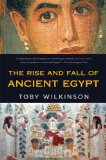Summary | Excerpt | Reviews | Beyond the Book | Readalikes | Genres & Themes | Author Bio

Critics' Opinion:
Readers' Opinion:
First Published:
Mar 2011, 656 pages
Paperback:
Jan 2013, 656 pages
 Book Reviewed by:
Book Reviewed by:
Kevin Bartolotta
Buy This Book
While Narmer may be the first historical king, he is not the beginning of Egypt's story. The decoration of his famous palette shows the art of the Egyptian royal court and the iconography of kingship already in their classical forms. However, some of the palette's stranger motifs, such as the intertwined beasts with long serpentine necks and the bull trampling the walls of an enemy fortress, hark back to a remote prehistoric past. On his great commemorative palette, Narmer was explicitly acknowledging that the cornerstones of Egyptian civilization had been laid long before his own time.
The desert blooms
As the Narmer Palette demonstrates on a small scale and for an early date, the Egyptians achieved a mastery of stone carving unsurpassed in the ancient, or modern, world. Diverse and abundant raw materials within Egypt's borders combined with great technical accomplishment to give the Egyptians a highly distinctive medium for asserting their cultural identity. Stone also had the advantage of permanence, and Egyptian monuments were consciously designed to last for eternity. The origin of this obsession with monumentality was in the Western Desert, near the modern border between Egypt and Sudan. The remote spot is known to archaeologists as Nabta Playa. Today, a paved main road carves through the desert only a mile or two away, bringing construction traffic to Egypt's New Valley project. But until very recently, Nabta Playa was as far away from civilization as it was possible to get. Its main distinction was as a pit stop on the cross- country route between the desert springs of Bir Kiseiba and the shores of Lake Nasser. The flat bed of an ancient, dried-up lake-or playa-together with a nearby sandy ridge, certainly make Nabta an ideal spot for an overnight camp. There is, however, much more to the site than a casual first glance would suggest. Scattered throughout the landscape are large stones-not naturally occurring boulders but megaliths that had been hauled from some distance away and set up at key points around the edge of the playa. Some stand in splendid isolation, as sentinels on the horizon; others form a linear alignment. Most remarkable of all, on a slight elevation a series of stones has been set out in a circle, with pairs of uprights facing each other. Two pairs are aligned north to south, while two more point toward the midsummer sunrise.
Previously unknown and entirely unexpected, Nabta Playa has emerged from obscurity as the ancient Egyptian Stonehenge, a sacred landscape dotted with carefully placed stone structures. Scientific dating of the associated sediments has revealed a startlingly early date for these extraordinary monuments, the early fifth millennium b.c. At that time, as in even earlier periods, the Sahara would have been very different from its current arid state. On an annual basis, summer rains would have greened the desert-filling the seasonal lake, and turning its shores into lush pasture and arable land. The people who migrated to Nabta Playa to take advantage of this temporary abundance were seminomadic cattle herders who roamed with their livestock across a wide area of the eastern Sahara. Large quantities of cattle bones have been excavated at the site, and traces of human activity can be found scattered over the ground: fragments of ostrich eggshells (used as water carriers and, when broken, for making jewelry), flint arrowheads, stone axes, and grindstones for processing the cereals that were cultivated along the lakeshore. With its seasonal fertility, Nabta offered semi-nomadic people a fixed point of great symbolic significance, and over generations they set about transforming it into a ritual center. Laying out the stone alignments must have required a large degree of communal involvement. Like their counterparts at Stonehenge, the monuments of Nabta show that the local prehistoric people had developed a highly organized society. A pastoral way of life certainly needed wise decision-makers with a detailed knowledge of the environment, close familiarity with the seasons, and an acute sense of timing. Cattle are thirsty animals, requiring a fresh supply of water at the end of each day's wandering, so judging when to arrive at a site such as Nabta and when to leave again could have been a matter of life and death for the whole community.
Excerpted from The Rise and Fall of Ancient Egypt by Toby Wilkinson Copyright © 2011 by Toby Wilkinson. Excerpted by permission of Random House, a division of Random House, Inc. All rights reserved. No part of this excerpt may be reproduced or reprinted without permission in writing from the publisher.





The Funeral Cryer by Wenyan Lu
Debut novelist Wenyan Lu brings us this witty yet profound story about one woman's midlife reawakening in contemporary rural China.
Your guide toexceptional books
BookBrowse seeks out and recommends the best in contemporary fiction and nonfiction—books that not only engage and entertain but also deepen our understanding of ourselves and the world around us.